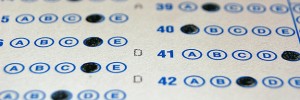Support for StateImpact Indiana comes from
About StateImpact Indiana
StateImpact Indiana is a collaboration of WFIU and Indiana Public Broadcasting stations to explain the effects of state education policy on people's lives.-
Multimedia
-
Featured Posts
Tracking Legislation In The 2015 “Education Session”
Countless lawmakers have dubbed 2015 the year of the “education session” in the General Assembly.
It’s an apt nickname – there are a ton of school-related issues to keep track of right now. So much so that even experts get confused about which bill is which, and where it is in the process of potentially becoming law.
So, let’s break it down.
Here’s an up-to-date, easy-to-read list of the bills we’re following at StateImpact and where those measures are in the process – followed by links to the bills themselves and some of our continuing coverage:
Bill | Author | Description | Status | Next Step |
|---|---|---|---|---|
| HB 1001 | Rep. Timothy Brown | State budget | Conference committee report passed by both chambers | Awaiting signature |
| HB 1009 | Rep. Robert Behning | Replaces ISTEP+ with BEST testing program *(Originally established Freedom to Teach fund to provide grants to designated "zones," schools or districts) | Conference committee report passed by both chambers | Awaiting signature |
| HB 1042 | Rep. Casey Cox | Requires colleges to provide annual loan information to students receiving Frank O'Bannon grants or twenty-first century scholarships. | Signed by Governor Pence - now Public Law 15 | |
| HB 1072 | Rep. Jeffrey Thompson | Shifts responsibility to run the contracting process for creating the statewide ISTEP+ test from the Department of Education to the State Board of Education. | Died in third reading in the House | |
| HB 1129 | Rep. Sue Errington | Expands the "On My Way Pre-k" pilot program to include 13 counties that were selected as finalists by the FSSA. | Has not moved forward from House Committee on Education | |
| HB 1146 | Rep. David Frizzell | Provides that a referendum on a controlled project may be held only at a general election. | Has not moved forward from House Committee on Ways & Means | |
| HB 1194 | Rep. Edward Clere | Establishes study about the need for changes to Indiana diploma types to accommodate students in special education and career & technical education programs. | Final amendments accepted in House | Awaiting signature |
| HB 1201 | Rep. Lloyd Arnold | Increases the number of State Board of Education members from 11 to 13. Sets forth qualifications for members appointed by the governor. | Has not moved forward from House Committee on Education | |
| HB 1486 | Rep. Jeffrey Thompson | Allows the State Board of Education to appoint an “executive director.” | Died in third reading in the House | |
| HB 1609 | Rep. Jud McMillin | Removes state superintendent as chair of the State Board of Education, instead allowing board members to elect a chairperson each year. | Has not moved forward from Senate Committee on Education & Career Development | Elements may be included in SB1 |
| HB 1637 | Rep. Robert Behning | Changes an existing law requiring students who score poorly on state tests to be identified for remedial help. | Conference committee report passed by both chambers | Awaiting signature |
| SB 1 | Sen. Travis Holdman | Allows the State Board of Education to elect its own chairperson annually. | Conference committee report passed by both chambers | Awaiting signature |
| SB 24 | Sen. James Buck | Gives the governor authority to appoint the state superintendent of public instruction after January 10, 2021. | Has not moved forward from Senate Committee on Rules & Legislative Procedure | |
| SB 62 | Sen. Dennis Kruse | Originally intended to contract out for physical education – House added an amendment to fast-track shortening the ISTEP+ test for spring 2015. | Signed by Governor Pence - now Public Law 1 | |
| SB 169 | Sen. Erin Houchin, Sen. Pete Miller, Sen. Ryan Mishler | Requires the IREAD-3 test be given to students by grade 2. | Died in Senate Committee on Appropriations | |
| SB 233 | Sen. James Smith | Allows school corporation to teach students about the history of winter holidays, use traditional holiday greetings and display non-religious holiday displays on school grounds. | Has not moved forward from House Committee on Government & Regulatory Reform | |
| SB 259 | Sen. Ronald Grooms, Sen. Erin Houchin, Sen. Dennis Kruse | Establishes an early learning STEP associate degree model program, for which 10 state high schools would be selected to participate. | Has not moved forward from House Committee on Education | |
| SB 344 | Sen. Earline Rogers | Expands the "On My Way Pre-k" pilot program to include 13 counties that were selected as finalists by the FSSA. | Has not moved forward from Senate Committee on Education & Career Development | |
| SB 452 | Sen. Travis Holdman | Allows State Board of Education members to elect a chairperson annually from within their ranks. | Died in Senate Committee on Rules & Legislative Procedure | Elements may be included in SB1 |
| SB 453 | Sen. Travis Holdman | Allows the governor and various state legislators to appoint members to the State Board of Education. | Died in Senate Committee on Rules & Legislative Procedure | Elements may be included in SB1 |
| SB 566 | Sen. Ryan Mishler, Sen. Luke Kenley | Prohibits Indiana from adopting a nationally constructed standardized test *(Originally replaced the ISTEP+ test with national testing program beginning in the 2016 school year) | Conference committee report passed by both chambers | Awaiting signature |
Source: Indiana General Assembly
Curious what all that means? Here’s a quick reminder of how a bill becomes a law on the state level (keep in mind, at any step in this system doesn’t happen, the bill “dies”):
(A) PRE-INTRODUCTION: An idea is developed, and a senator or representative decides to sponsor it. He or she drafts a bill, with research and technical help from the nonpartisan Legislative Services Agency (LSA).
(B) INTRODUCTION: The representative enters the bill into his or her respective chamber. The only exception here is that bills raising revenue can only originate in the House.
(C) CONSIDERATION: This is where the sausage is made. Chamber leadership calls the bill for discussion.
- First reading: The bill is read aloud to the entire chamber and assigned to an appropriate chamber committee for review.
- Committee: The committee chairperson puts the bill up for public hearing, where the full committee hears testimony, discusses merits and pitfalls of the measure, and votes to advance the bill.
- Second reading: The bill is returns to the chamber it came from for discussion before the entire body. Any legislator in that body can suggest amendments to the bill, which have to be approved by a majority vote. After all approved amendments have been added, the chamber votes to advance the bill as a whole. The chamber may also send the bill back to committee, if they need more information.
- Third reading: The same chamber now schedules the same bill for a third discussion. This is the same process as the second reading, except that any proposed amendments must be approved by a two-thirds majority. The chamber votes to advance the bill as a whole.
- Opposite chamber: The bill moves to the other legislative chamber, who then repeats the same process of consideration (first reading > committee > second reading > third reading).
- Finalizing: The bill returns to the chamber of origin, which must approve or deny any amendments their counterparts added. If approved, the bill moves on. If denied, the bill goes to a conference committee – a group made up of two members from each chamber, one from each political party. Once they reach agreement, the bill returns to both chambers for approval.
(D) GOVERNOR’S ACTION: The bill is presented to the governor, who has seven days to act. He or she has three options: He can sign the bill, in which case it becomes law; He can do nothing, in which case the bill becomes law without his signature; or, he can veto the bill, in which case it goes back to the House and Senate, who have the opportunity to over-ride the veto with a two-thirds majority vote. If both chambers achieve that majority, the bill becomes law.
Keep in mind, even if a bill dies, the language of that bill can be put into another bill (although that’s not guaranteed). That’s why issues aren’t technically considered dead until the session officially ends in April.
Got it? If you want to see other explanations, check out how the General Assembly itself and the Indiana Chamber of Commerce spell it out.




